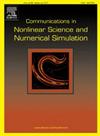Multi-scale modeling of Snail-mediated response to hypoxia in tumor progression
IF 3.4
2区 数学
Q1 MATHEMATICS, APPLIED
Communications in Nonlinear Science and Numerical Simulation
Pub Date : 2025-02-17
DOI:10.1016/j.cnsns.2025.108673
引用次数: 0
Abstract
Tumor cell migration within the microenvironment is a crucial aspect for cancer progression and, in this context, hypoxia has a significant role. An inadequate oxygen supply acts as an environmental stressor inducing migratory bias and phenotypic changes. In this paper, we propose a novel multi-scale mathematical model to analyze the pivotal role of Snail protein expression in the cellular responses to hypoxia. Starting from the description of single-cell dynamics driven by the Snail protein, we construct the corresponding kinetic transport equation that describes the evolution of the cell distribution. Subsequently, we employ proper scaling arguments to formally derive the equations for the statistical moments of the cell distribution, which govern the macroscopic tumor dynamics. Numerical simulations of the model are performed in various scenarios with biological relevance to provide insights into the role of the multiple tactic terms, the impact of Snail expression on cell proliferation, and the emergence of hypoxia-induced migration patterns. Moreover, quantitative comparisons with experimental data show the model’s reliability in measuring the impact of Snail transcription on cell migratory potential. Through our findings, we shed light on the potential of our mathematical framework in advancing the understanding of the biological mechanisms driving tumor progression.
求助全文
约1分钟内获得全文
求助全文
来源期刊

Communications in Nonlinear Science and Numerical Simulation
MATHEMATICS, APPLIED-MATHEMATICS, INTERDISCIPLINARY APPLICATIONS
CiteScore
6.80
自引率
7.70%
发文量
378
审稿时长
78 days
期刊介绍:
The journal publishes original research findings on experimental observation, mathematical modeling, theoretical analysis and numerical simulation, for more accurate description, better prediction or novel application, of nonlinear phenomena in science and engineering. It offers a venue for researchers to make rapid exchange of ideas and techniques in nonlinear science and complexity.
The submission of manuscripts with cross-disciplinary approaches in nonlinear science and complexity is particularly encouraged.
Topics of interest:
Nonlinear differential or delay equations, Lie group analysis and asymptotic methods, Discontinuous systems, Fractals, Fractional calculus and dynamics, Nonlinear effects in quantum mechanics, Nonlinear stochastic processes, Experimental nonlinear science, Time-series and signal analysis, Computational methods and simulations in nonlinear science and engineering, Control of dynamical systems, Synchronization, Lyapunov analysis, High-dimensional chaos and turbulence, Chaos in Hamiltonian systems, Integrable systems and solitons, Collective behavior in many-body systems, Biological physics and networks, Nonlinear mechanical systems, Complex systems and complexity.
No length limitation for contributions is set, but only concisely written manuscripts are published. Brief papers are published on the basis of Rapid Communications. Discussions of previously published papers are welcome.
 求助内容:
求助内容: 应助结果提醒方式:
应助结果提醒方式:


